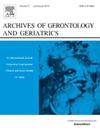Exploring the association between cumulative hs-CRP and all-cause mortality, with consideration of cardiometabolic mediators in middle-aged and elderly adults: Insights from observational study
IF 3.8
3区 医学
Q2 GERIATRICS & GERONTOLOGY
引用次数: 0
Abstract
Background
Under a state of sustained relatively low inflammation, it is uncertain if cumulative high-sensitivity C-reactive protein (cumhs-CRP) can predict all-cause mortality, and its impact on it through cardiometabolic factors is also unknown.
Methods
This is a longitudinal national cohort study using CHARLS data. Specifically, we only included participants aged 45 and older with hs-CRP levels below 10mg/L in both 2012 and 2015. Cumhs-CRP derived through time-weighted averaging was employed as the key exposure. Death events were recorded as the primary outcome. All-cause mortality is defined as death occurring at any point from 2015 to 2018. Variables selection and interpretation were conducted by Boruta and Shapley Additive Explanations (SHAP). Further mediation analysis explored the possibility of cardiometabolic factors serving as mediators. Additional Mendelian randomization was conducted to demonstrate the robustness of the association.
Results
5052 Chinese adults over 45 years of age with hs-CRP levels below 10mg/L over time were included. Boruta identified 16 possible variables, with SHAP confirming the importance of cumhs-CRP. Multivariate analysis showed a significant association between cumhs-CRP and mortality (OR 1.05, 95 % CI 1.02 1.09, p = 0.003), and a linear relationship was observed (p-nonlinear = 0.184). Importantly, cumhs-CRP indirectly may affect the risk of death through systolic and diastolic blood pressure, fasting glucose, and uric acid, with proportions of 17.4 %, 8.2 %, 5.2 %, and 17 %, respectively.
Conclusions
Cumhs-CRP levels are associated with increased mortality risk, even in individuals with lower baseline levels. Regular monitoring of hs-CRP levels may aid in identifying individuals with elevated mortality risk.
探索累积hs-CRP与全因死亡率之间的关系,考虑到中老年人的心脏代谢介质:来自观察性研究的见解
背景:在持续相对低炎症状态下,累积的高敏c反应蛋白(cumhs-CRP)是否能预测全因死亡率尚不确定,其通过心脏代谢因子对全因死亡率的影响也尚不清楚。方法采用CHARLS数据进行全国纵向队列研究。具体来说,我们在2012年和2015年只纳入了年龄在45岁及以上、hs-CRP水平低于10mg/L的参与者。通过时间加权平均得出的Cumhs-CRP作为关键暴露量。死亡事件被记录为主要结局。全因死亡率被定义为2015年至2018年期间任何时间点发生的死亡。变量选择和解释采用Boruta和Shapley加性解释(SHAP)。进一步的中介分析探讨了心脏代谢因子作为中介的可能性。另外进行孟德尔随机化以证明该关联的稳健性。结果纳入5052名年龄在45岁以上、hs-CRP水平长期低于10mg/L的中国成年人。Boruta确定了16个可能的变量,其中SHAP证实了cumhs-CRP的重要性。多因素分析显示cumhs-CRP与死亡率有显著相关性(OR 1.05, 95% CI 1.02 1.09, p = 0.003),并观察到线性关系(p-非线性= 0.184)。重要的是,cumhs-CRP可能通过收缩压和舒张压、空腹血糖和尿酸间接影响死亡风险,其比例分别为17.4%、8.2%、5.2%和17%。结论:scumhs - crp水平与死亡风险增加有关,即使在基线水平较低的个体中也是如此。定期监测hs-CRP水平有助于识别死亡风险增高的个体。
本文章由计算机程序翻译,如有差异,请以英文原文为准。
求助全文
约1分钟内获得全文
求助全文
来源期刊
CiteScore
7.30
自引率
5.00%
发文量
198
审稿时长
16 days
期刊介绍:
Archives of Gerontology and Geriatrics provides a medium for the publication of papers from the fields of experimental gerontology and clinical and social geriatrics. The principal aim of the journal is to facilitate the exchange of information between specialists in these three fields of gerontological research. Experimental papers dealing with the basic mechanisms of aging at molecular, cellular, tissue or organ levels will be published.
Clinical papers will be accepted if they provide sufficiently new information or are of fundamental importance for the knowledge of human aging. Purely descriptive clinical papers will be accepted only if the results permit further interpretation. Papers dealing with anti-aging pharmacological preparations in humans are welcome. Papers on the social aspects of geriatrics will be accepted if they are of general interest regarding the epidemiology of aging and the efficiency and working methods of the social organizations for the health care of the elderly.

 求助内容:
求助内容: 应助结果提醒方式:
应助结果提醒方式:


